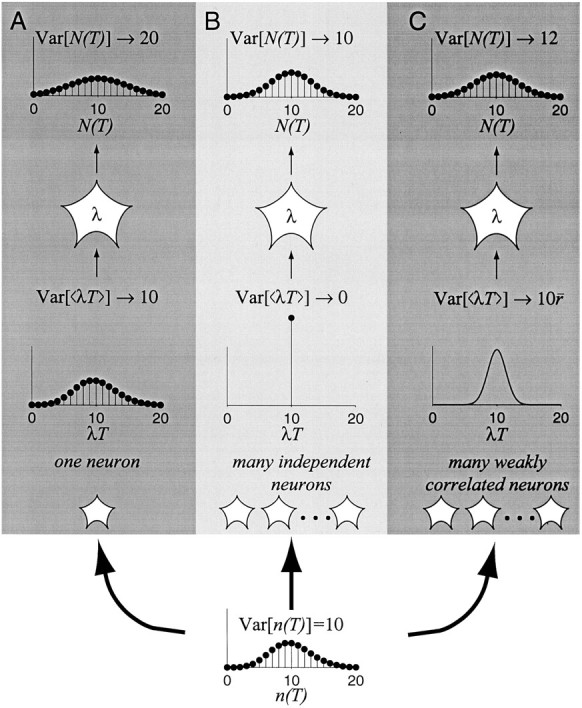Fig. 12.

Propagation of noise among ensembles of neurons. Each of the neurons depicted in this figure emits a spike train idealized as a Poisson point process. The three neurons at thetop compute the average spike rate among their inputs and emit the answer as a Poisson spike train. During a 100 msec epoch, the input neurons (bottom) discharge at 100 spikes/sec. Each input neuron is therefore expected to generate 10 spikes, but in any one epoch the count may vary. The bottom graph shows the Poisson distribution of spike counts from one input neuron. Themiddle row of graphs shows the probability density of the quantity that the output neuron has computed: the number of spikes per input neuron. The neuron obtains an estimate of the input spike count by calculating with one (A) or more neurons (B, C). The value is represented as an expectation, 〈λT〉, which can be thought of as a desired rate times the epoch duration. In any one epoch, the neuron emits a Poisson spike train at a rate, λ, resulting in N(T) spikes. The distribution of N(T) from many 100 msec repetitions is shown at the top. A, If the output neuron receives input from just one input neuron, the variance of the input count, var [〈λT〉], is 10. The output neuron emits an average of 10 spikes, but the variance is 20, reflecting the sum of input and (its own) Poisson variance. B, If there are many independent inputs, then the variance of the mean input count is negligible (delta function; middle plot). The output neuron emits an average of 10 spikes, and the variance is 10, the amount of variance expected for a Poisson spike train. C, If there are many weakly correlated input neurons, then the variance of the mean input count is approximately 10 times the average correlation coefficient among the input neurons. If = 0.2, then the variance is 2. The output neuron emits an average of 10 spikes, but the total variance is 12. Notice that in A and C, the variance of the output spike count exceeds the variance of the inputs.
